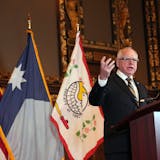Pedal, pedal, pedal, plonk.
I looked up from the ground, the lime green body of the NiceRide I'd rented moments before splayed on top of me. I willed myself to stand up before any passersby saw. It was a mid-morning on a sunny Friday in early July, and few people were out and about in this quiet corner of Linden Hills. But the shock of embarrassment hit just as hard the pavement against my right hip.
At 32 years old, I was teaching myself to ride a bike.
Now, please believe me when I say I once knew how to ride. I have very vivid memories of learning in the parking lot behind my parents' apartment in Farsta, Sweden. I even called my mom to confirm that my neurons weren't deceiving me.
"Oh, Maggie, you were so proud of yourself," she said wistfully, remembering the day she pulled off my training wheels. "You were four, in the prettiest dress, bangs blowing in the breeze as you rode circles around us. Why?"
Well, I'm going to teach myself how to ride …
"What are you talking about?" I could practically hear her eyes narrow as her disapproving tone reached through the phone line. "You know how to ride a bike. That's why they say, 'It's just like riding a bike.' You never forget."
Except, what if riding a bike is not "like riding a bike" at all? What if, in my case, the more apt cliché is "use it or lose it"?



